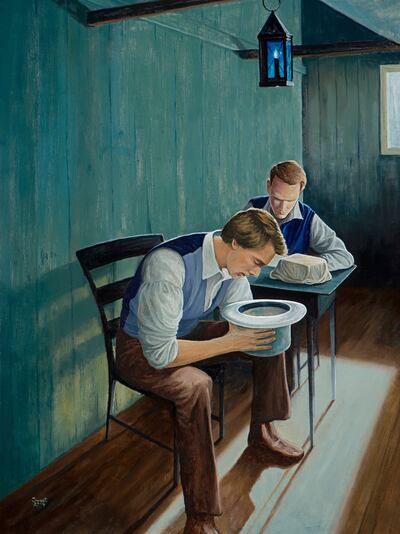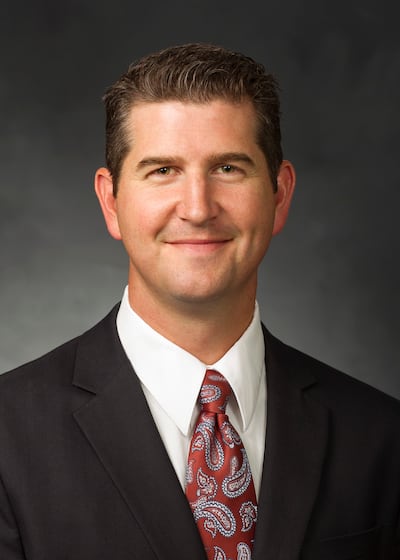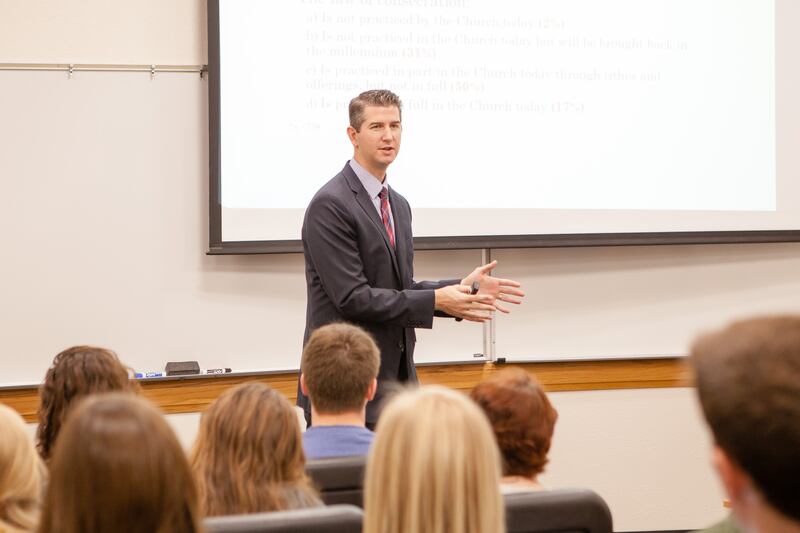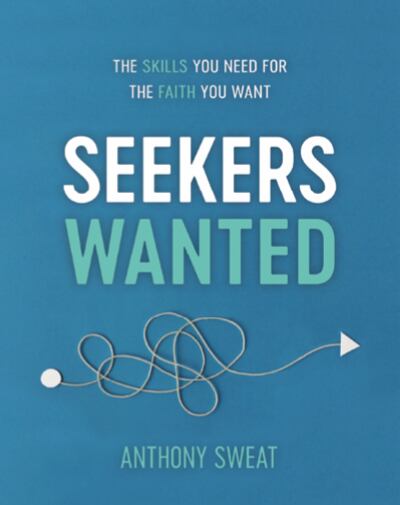SALT LAKE CITY — For several years now, Anthony Sweat has been teaching the restored gospel of Jesus Christ on multiple platforms.
First, he’s an associate professor of church history and doctrine at Brigham Young University.
Secondly, he’s authored and co-authored several books.
Thirdly, he’s used a paint brush.
“My original career plan was to be a full-time studio artist,” said Sweat, who earned a degree in painting and drawing from the University of Utah. “I joke that the Lord saved me from a life of poverty and led me into the big money of religious education instead.”

Understanding the power of visual imagery and wanting people to learn about the Restoration through his artwork, Sweat began creating art that depicted church history themes not previously painted, or if so, a more accurate portrayal.
One of his paintings, “The Gift and Power of God,” shows Joseph Smith translating the Book of Mormon by using a seer stone(s) placed in a hat, based on several historic accounts that consistently mention the prophet using a hat.
“I wanted to give a more faithful representation of it,” said Sweat, who has now painted close to 30 different scenes of the restoration that will be featured in a forthcoming book. “It’s been well received for the most part.”
Sweat uses his painting in his new book, “Seekers Wanted,” to teach how to take the right approach to studying church history.
The 171-page book offers readers skills, tools and other resources for how to seek learning by study and faith, Sweat said.
“I don’t want to tell people what to think, I want to help them with how to think and particularly, what to seek,” Sweat said.
Sweat recently took a break from his classes and research to discuss the inspiration for “Seekers Wanted,” along with interesting aspects of his life and career in an interview with the Deseret News.
This interview has been edited for length and clarity.

Deseret News: You served a mission in La Paz, Bolivia. What’s one thing you learned as a missionary that continues to bless your life?
Anthony Sweat: La Paz was a difficult mission. My first city was at 14,000 feet in the tops of the Andes Mountains, living in a mud house with a tin roof. There wasn’t hardly anybody there I could talk to. Most of them were indigenous Bolivians, with a very different culture and worldview than mine. Nobody spoke English. For a young, fairly sheltered 19-year-old kid from Utah, it was not just culture shock, it was a lesson in how you grow close to God. The Lord lets us experience difficulty and see our weakness so we can learn to rely on his grace and strength. I realized quickly that I would not be able to do things on my own, that I was a very weak and flawed person. But with him, his strength, his grace and help, I can do the things he needs me to do. That’s been a lesson that has stayed with me my whole life that I’ve called on many times.
DN: Prior to coming to BYU, you taught seminary for 13 years. What is your favorite gospel topic to teach to teenagers?
AS: A number of years ago, one of my first books I ever wrote was for teenagers. It was called, “I’m Not Perfect, Can I Still Go to Heaven?” I think my favorite topic is to try to help them understand our covenant relationship with Jesus. If you are a covenant person it’s the covenant that saves you, your spiritual marriage to Jesus, so to speak. It’s not your qualifications. It’s not your words. We’re not earning our way to heaven. We’re not trying to be perfect so we can qualify ourselves for heaven, we’re trying to qualify ourselves for Christ and the covenant so he can take us to heaven on his merits.
That’s one of my favorite things to teach teenagers particularly because generally when you are a teenager, that’s when you start to make real mistakes and sin. You see the need for repentance. It’s a timely message for them to grasp at that time in their lives, and the joy of the gospel covenant because of it. I’d much rather talk about that than things like fun dating lessons. I want to give them the core of the gospel.
DN: What is the most challenging aspect of being a church history professor at BYU?
AS: The thing that is most challenging is you have students with a wide variety of perspectives, experiences and needs, along with a wide variety of questions. I teach bigger classes — all of my classes are 200-250 students. So to teach in a way that is meeting the needs of a broad student body base. Some of them are intellectual. Some of them come from some exotic backgrounds in the sense that they have a lot of life and world travel experience. Some are fairly sheltered. Some are international students, some are from Provo. Some are returned missionaries, some are not. Some are married, some are not. Some could have gone to an Ivy League school. Others are simply struggling with faith. Others just want to follow the prophet and be close to Jesus. They don’t want to think about some of these complex issues that people bring up about the church.

The challenge is to teach in a way that meets the needs and appeals to a broad student body. To me, finding that middle road where everyone finds enlightenment and edification from your class is a challenge. But it’s a fun challenge.
DN: What inspired you to write “Seekers Wanted”? Why is it timely?
AS: What inspired this book has been the myriad discussions I’ve had over the last five or six years, particularly at BYU and with students I have spoken with at different conferences and events around the country.
What I perceived was that we need to give people better skills. In my book, I don’t directly answer certain “hot” topic questions, even though I’ll use them as examples. My point is more to give people the tools and abilities so that they know how to seek learning by study and faith themselves, to help them be more self-sufficient learners and seek after the right things.
President M. Russell Ballard’s 2016 talk, “The Opportunities and Responsibilities of CES Teachers in the 21st Century,” was a major catalyst for the book. One phrase that really stuck out to me was, “Gone are the days when a student asked an honest question and a teacher responds, ‘Don’t worry about it!’ Gone are the days when a student raised a sincere concern and a teacher bore his or her testimony as a response intended to avoid the issue. Gone are the days when students were protected from people who attacked the church.” He went on to say you need to “model” for your students how to seek learning by study and faith and to demonstrate those skills. I hope this book, in some small way, can help fulfill some of that directive from President Ballard.

DN: How long did it take you to write the book?
AS: I once heard David McCullough, the historian and great biographer, say the question people often don’t ask is, “How much time did you take thinking about it?” I think most of the work is thinking — thinking through things, how to approach things and how to help. This book is the culmination of six or seven years of thinking through some of these things and teaching them to students. I’ve been thinking about these issues for a long time. The writing process took about a year, but this book is the culmination of literally thousands of discussions and classes.

All writing is autobiography. I believe this book is also a reflection of me and my experiences.
DN: What message would you like readers to take from “Seekers Wanted”?
AS: My hope is to help people come unto Christ and love the restoration, as well as the covenants of the restoration. It’s written in a way that I hope appeals to a situation for every member of the church. I think there’s chapters in here that would help every member of the church to be a seeker of truth. So I hope they can view this book that way and find some benefit.


